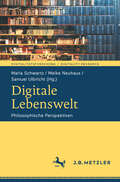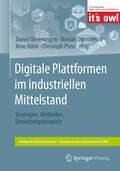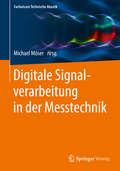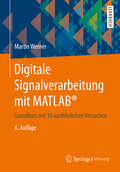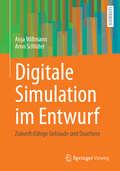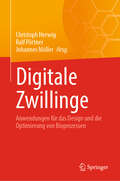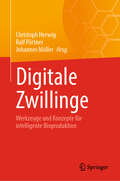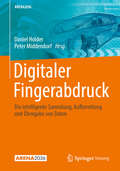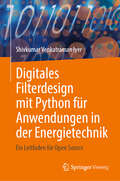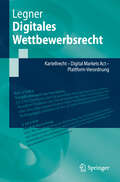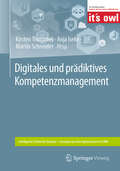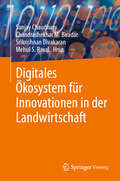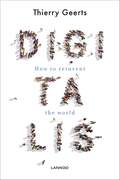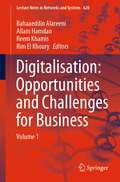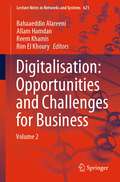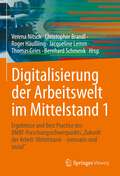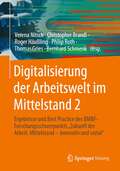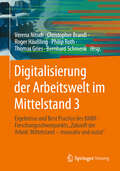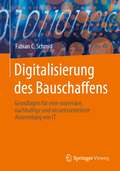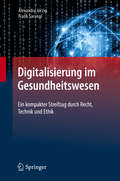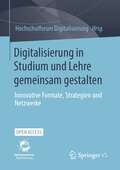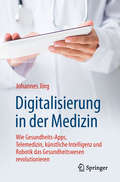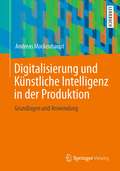- Table View
- List View
Digitale Lebenswelt: Philosophische Perspektiven (Digitalitätsforschung / Digitality Research)
by Samuel Ulbricht Meike Neuhaus Maria SchwartzDer Begriff der Lebenswelt ist ein genuin philosophischer Begriff, der ursprünglich in der Phänomenologie beheimatet ist und inzwischen von vielen anderen Fachwissenschaften sowie Fachdidaktiken aufgegriffen wurde. Geht es nun um die digitale Dimension der Lebenswelt oder – je nach Definition – die digitale Durchdringung derselben, ist die Forschung dementsprechend interdisziplinär aufgestellt. Ein spezifisch philosophischer Zugang zur ‚digitalen Lebenswelt‘ findet sich bis dato nur vereinzelt und soll mit diesem Band bewusst unternommen werden. Nach grundsätzlichen Überlegungen zum Begriff werden ausgewählte Phänomene unter den Aspekten des ‚Selbst‘ und der ‚Gemeinschaft‘ genauer betrachtet (z.B. Leiblichkeit, VR/AR, Internetpornografie, Metaversum, Soziale Netzwerke und digitale Teilhabe). Der letzte Teil befasst sich mit Computerspielen als Bereich, der besonders viele Anknüpfungspunkte philosophischer und ethischer Diskussion bietet.
Digitale Plattformen im industriellen Mittelstand: Strategien, Methoden, Umsetzungsbeispiele (Intelligente Technische Systeme – Lösungen aus dem Spitzencluster it’s OWL)
by Christoph Plass Daniel Beverungen Roman Dumitrescu Arno KühnDieses Buch stellt neue Strategien, Methoden und Umsetzungsbeispiele vor, mit denen digitale Plattformen zur Realisierung erfolgreicher Geschäftsstrategien im industriellen Mittelstand eingesetzt werden. Digitale Plattformen sind Erfolgsgaranten für viele Weltmarktführer im Konsumgüterbereich. Aber auch der industrielle Mittelstand kann mit ihrer Hilfe neue Geschäftsfelder erschließen und Wettbewerbsvorteile realisieren. In diesem Band zeigen wir auf, warum sich produzierende Unternehmen schon heute in diesem Wettbewerbsumfeld positionieren müssen und welche strategischen Handlungsoptionen existieren. Ein strukturierter Transformationspfad zeigt, wie der industrielle Mittelstand über die Etablierung digitaler Dienstleistungen den Sprung in die Plattformökonomie schaffen kann. Innovative Methoden und Werkzeuge bieten konkrete Hilfestellung, um diesen Transformationsprozess strategisch zu planen und umzusetzen. Zwei ausgewählte Praxisbeispiele zeigen schließlich auf, wie der Einstieg in die Plattformökonomie erfolgreich gelingt.
Digitale Signalverarbeitung in der Messtechnik (Fachwissen Technische Akustik)
by Michael MöserIn diesem Band der Reihe Fachwissen Technische Akustik werden Grundlagen der Abtastung und Quantisierung, digitale Filter sowie mehrere digitale Signalverarbeitungsmethoden beschrieben: Echtzeit-Frequenzanalysator, 2-Kanal-FFT-Analysator mit Sweep- oder Rauschanregung und Maximalfolgenmesstechnik. Anwendungen und Fehlerquellen der digitalen Messverfahren werden an Beispielen diskutiert.
Digitale Signalverarbeitung mit MATLAB®: Grundkurs mit 16 ausführlichen Versuchen (Studium Technik Ser.)
by Martin WernerDas Buch führt in die Grundlagen und Anwendungen der digitalen Signalverarbeitung durch praktische MATLAB®-Übungen am PC ein. Angeboten werden 16 Versuche mit klaren Lernzielen, ausführlichen Einführungen und erklärenden Lösungen. Die Versuchsvorbereitungen bauen idealerweise auf erste Erfahrungen aus einer einführenden Lehrveranstaltung in Signale und Systeme auf. Ein PC mit dem Programmpaket MATLAB® mit der Signal Processing Toolbox wird vorausgesetzt. Nützliche MATLAB®-Werkzeuge werden einbezogen, so dass das Gelernte unmittelbar in die Praxis übertragen werden kann. Die Programme und Datensätze zum Buch sind auf der Produktseite der Verlagshomepage kostenlos verfügbar.
Digitale Simulation im Entwurf: Zukunftsfähige Gebäude und Quartiere
by Anja Willmann Arno SchlüterDieses Lehrbuch zeigt Möglichkeiten auf, wie Architekt/innen mithilfe vereinfachter dynamischer Simulationen bereits in den ersten Entwurfsphasen klimatische und energetische Konzepte auf verschiedenen Maßstäben auf ihre Wirksamkeit hin überprüfen und in den Entwurf integrieren können. Der thermische Komfort im Innenraum gibt Auskunft über die Behaglichkeit des Nutzers und kann mit dem Einsatz passiver Strategien in Form von Konstruktion, Materialwahl, Lüftungsstrategien, Pufferzonen, Solare Gewinne etc. bewusst erhöht werden, bevor ergänzend gebäudeintegrierte Technologien oder urbane Infrastrukturen zur Energieproduktion oder Versorgung zum Einsatz kommen. Neben den physikalischen Grundlagen und Wirkungsweisen passiver Strategien in verschiedenen Klimazonen werden die Möglichkeiten in Kombination mit aktiven Technologien erläutert, um komfortable, treibhausgasneutrale Gebäude zu entwerfen. Auf städtischer Ebene werden die Wechselwirkungen zwischen Gebäuden, städtischen Rahmenbedingungen und Infrastruktur erläutert und anhand von Beispielen aufgezeigt. Mit dem City Energy Analyst wird ein Werkzeug vorgestellt, mit dem Energieströme in Quartieren unter Berücksichtigung passiver und aktiver Ansätze simuliert und Strategien zur Dekarbonisierung entwickelt werden können.
Digitale Zwillinge: Anwendungen für das Design und die Optimierung von Bioprozessen
by Ralf Pörtner Christoph Herwig Johannes MöllerDies ist der zweite von zwei Bänden, die zusammen einen Überblick über die neuesten Fortschritte bei der Erzeugung und Anwendung digitaler Zwillinge in der Bioprozessentwicklung und -optimierung geben. Bioprozesse haben sich in den letzten Jahrzehnten stark entwickelt, von datengetriebenen Ansätzen hin zur Digitalisierung der Bioprozessindustrie im 21. Jahrhundert. Darüber hinaus erfordert die hohe Nachfrage nach biotechnologischen Produkten effiziente Methoden, sowohl in der Forschung und Entwicklung als auch im Technologietransfer und in der Routineproduktion. Ein vielversprechendes Werkzeug ist in diesem Zusammenhang der Einsatz von digitalen Zwillingen als virtuelle Darstellung des Bioprozesses. Sie spiegeln die Mechanik des biologischen Systems, die Wechselwirkungen zwischen Prozessparametern, Kennzahlen und Produktqualitätsmerkmalen in Form eines mathematischen Prozessmodells wider. Darüber hinaus ermöglichen digitale Zwillinge den Einsatz computergestützter Methoden, um ein besseres Prozessverständnis zu erlangen, neuartige Bioprozesse zu testen und zu planen sowie diese effizient zu überwachen. Dieses Buch konzentriert sich auf die Anwendung digitaler Zwillinge in verschiedenen Kontexten, z.B. computergestützte Versuchsplanung, Seed-Train-Vorhersage und Lifeline-Analyse. Die beiden Bände behandeln sowohl die Grundlagen als auch die Anwendungen und bieten damit eine ideale Einführung in das Thema für Forscher und Entwickler in Wissenschaft und Industrie.
Digitale Zwillinge: Werkzeuge und Konzepte für intelligente Bioproduktion
by Ralf Pörtner Christoph Herwig Johannes MöllerDies ist der erste von zwei Bänden, die zusammen einen Überblick über die neuesten Fortschritte bei der Erzeugung und Anwendung digitaler Zwillinge in der Bioprozessentwicklung und -optimierung geben. Bioprozesse haben sich in den letzten Jahrzehnten stark entwickelt, von datengetriebenen Ansätzen hin zur Digitalisierung der Bioprozessindustrie im 21. Jahrhundert. Darüber hinaus erfordert die hohe Nachfrage nach biotechnologischen Produkten effiziente Methoden, sowohl in der Forschung und Entwicklung als auch im Technologietransfer und in der Routineproduktion. Ein vielversprechendes Werkzeug ist in diesem Zusammenhang der Einsatz von digitalen Zwillingen als virtuelle Darstellung des Bioprozesses. Sie spiegeln die Mechanik des biologischen Systems, die Wechselwirkungen zwischen Prozessparametern, Kennzahlen und Produktqualitätsmerkmalen in Form eines mathematischen Prozessmodells wider. Darüber hinaus ermöglichen digitale Zwillinge den Einsatz computergestützter Methoden, um ein besseres Prozessverständnis zu erlangen, neuartige Bioprozesse zu testen und zu planen sowie diese effizient zu überwachen. Dieses Buch erläutert die mathematische Struktur digitaler Zwillinge, ihre Entwicklung und die einzelnen Teile des Modells sowie Konzepte zur wissensbasierten Erzeugung und strukturellen Variabilität digitaler Zwillinge. Die beiden Bände decken sowohl Grundlagen als auch Anwendungen ab und bieten damit den idealen Einstieg in das Thema für Forscher und Entwickler in Wissenschaft und Industrie gleichermaßen.
Digitaler Fingerabdruck: Die intelligente Sammlung, Aufbereitung und Übergabe von Daten (ARENA2036)
by Peter Middendorf Daniel HolderDieses Buch dokumentiert die Ergebnisse des Verbundprojekts Digitaler Fingerabdruck, das am Forschungscampus ARENA2036 durchgeführt wurde. Das Hauptziel war die Weiterentwicklung eines Bauteils zu einer Industrie 4.0-Komponente sowie die Schaffung der notwendigen Basis für die intelligente Wertschöpfungskette. Dabei wurden die einzelnen Prozessschritte verknüpft, um einen Mehrwert für jedes Bauteilindividuum und jeden Bauteiltypen zu erhalten. Dieser Mehrwert liegt in der Möglichkeit den Herstellungsprozess individuell einzustellen, ein hohes Maß an Flexibilität zu gewährleisten, jedes Bauteil zu jedem Zeitpunkt der Produktion sowie im Fahrzeugeinsatz bewerten zu können und in Echtzeit Rückmeldung zu bekommen. Hierfür wurde im Rahmen dieses Projekts eine Basis für die intelligente Wertschöpfungskette automobiler Strukturen in Form einer Datensammlung und intelligenten Datenübergabe sowie der Industrie 4.0-Angliederung geschaffen. Die Betrachtung der vorhandenen Daten sowie Datenformate ermöglichte eine semantische Beschreibung sowie einen ständigen Datenfluss aller notwendigen Daten zwischen den einzelnen Schritten der Wertschöpfungskette. Dies beinhaltete auch eine intelligente Datenablage, Datenaufbereitung sowie eine Kopplung an neue und bestehende Simulationsmethoden. Zudem wurden geeignete Fertigungsprozesse für die Herstellung der sensorintegrierten Industrie 4.0-Komponente definiert und optimiert. Die Versuchskampagne in verschiedenen Anwendungsszenarien ermöglichte die Überprüfung anhand von Realdaten und eine Potentialbewertung entlang der gesamten Wertschöpfungskette des Digitalen Fingerabdrucks.
Digitales Filterdesign mit Python für Anwendungen in der Energietechnik: Ein Leitfaden für Open Source
by Shivkumar Venkatraman IyerDiese Buch bietet eine ausführliche Beschreibung darüber, wie digitale Filter entworfen werden. Die Darstellung richtet sich an praktizierende Ingenieure und verwendet Open-Source-Computertools, wobei gleichzeitig grundlegende Signalverarbeitungstheorie einfließt. Der Autor integriert Theorie nach Bedarf und legt dabei einen Schwerpunkt auf die Umsetzung in die Praxis. Das Buch beschreibt Werkzeuge im Detail, die für das Filterdesign verwendet werden können, sowie die Schritte, um den gesamten Prozess zu automatisieren. Zerlegt die Theorie der Signalverarbeitung in einfache, verständliche Sprache für praktizierende Ingenieure. Bietet den Lesern eine äußerst praktische Einführung in das Design digitaler Filter. Verwendet Open-Source-Computertools und integriert dabei grundlegende Signalverarbeitungstheorie. Beschreibt Beispiele digitaler Systeme in der Ingenieurwissenschaft und wie sie in der Praxis umgesetzt werden. Enthält Fallstudien, in denen das Filterdesign von der Konzeption bis zur endgültigen Implementierung ausführlich beschrieben wird.
Digitales Wettbewerbsrecht: Kartellrecht – Digital Markets Act – Plattform-Verordnung (Springer-Lehrbuch)
by Sarah LegnerDas Lehrbuch thematisiert den Wettbewerbsschutz auf digitalen Märkten. Zum einen erläutert es Grundlagen und sektorspezifische Vertiefungen zum europäischen und deutschen Kartellrecht. Zum anderen werden der Digital Markets Act und die Plattform-Verordnung dargestellt. Die Bewältigung wettbewerblicher Risiken auf digitalen Märkten ist ein dynamisches Thema, welches Gesetzgebung und Rechtsprechung in den letzten Jahren intensiv beschäftigt hat. Dies bietet Anlass, den aktuellen Acquis zum „digitalen Wettbewerbsrecht“ aufzuarbeiten und Studierenden in fortgeschrittenen Semestern sowie Praktiker:innen den Zugang zu der noch jungen, aber ausbildungs- und praxisrelevanten Rechtsmaterie zu erleichtern.
Digitales und prädiktives Kompetenzmanagement (Intelligente Technische Systeme – Lösungen aus dem Spitzencluster it’s OWL)
by Martin Schneider Kirsten Thommes Anja IsekeDie Kompetenzen der Mitarbeitenden sind gerade in wissensintensivenUnternehmen der wichtigste Wettbewerbsfaktor. Viele Unternehmen stehen aktuellvor der Aufgabe, im Zuge der Digitalisierung Kompetenzen erfassen und entwickeln zu müssen.Diese Kompetenzen sollen Beschäftigte befähigen neue Aufgaben zu übernehmenund in sich ändernden Kontexten zu arbeiten. Die Herausforderung betrifft alleMitarbeiter, aber insbesondere auch die Arbeit in (agilen) Teams. Wir stellenein praxisorientiertes Framework für ein prädiktives Kompetenzmanagementfür agile Teams vor, das den Leser in die Lage versetzt, ein digitalesKompetenzmanagement für Unternehmen aufzubauen.
Digitales Ökosystem für Innovationen in der Landwirtschaft
by Sanjay Chaudhary Mehul S. Raval Chandrashekhar M. Biradar Srikrishnan DivakaranDieses Buch präsentiert die neuesten Erkenntnisse auf dem Gebiet des digitalen Ökosystems für Innovationen in der Landwirtschaft. Das Buch ist in zwei Abschnitte mit dreizehn Kapiteln unterteilt, die sich mit spezialisierten Bereichen befassen. Es gibt dem Leser einen Überblick über die Rahmenbedingungen und Technologien, die an der Digitalisierung der Landwirtschaft beteiligt sind, sowie über die Methoden zur Datenverarbeitung, Entscheidungsfindung und innovativen Dienste/Anwendungen zur Förderung digitaler Transformationen in der Landwirtschaft. Die Kapitel wurden von Experten verfasst, die ihre Erfahrungen in verständlicher Sprache durch Fallstudien, geeignete Illustrationen und Tabellen teilen. Der Inhalt wurde entwickelt, um die Bedürfnisse der Geoinformatik, Datenwissenschaften, Landwirtschafts- und Umweltwissenschaften von Universitäten, landwirtschaftlichen Universitäten, technologischen Universitäten, Forschungsinstituten und akademischen Hochschulen weltweit zu erfüllen.Es unterstützt Planer, politische Entscheidungsträger und Erweiterungswissenschaftler bei der Planung und nachhaltigen Bewirtschaftung von Landwirtschaft und natürlichen Ressourcen.
Digitalis: How to Reinvent the World
by Thierry GeertsAll too often the digital revolution is depicted as a global nightmare: companies are shut down, jobs are cut, and the future is looking grim. Others try to take action and are bracing themselves for the giant disruption that is looming around the corner. In his thought-provoking book, Thierry Geerts proposes to replace the word 'disruption' with 'reinvention'. Take the car, for instance. The way we have been driving around for the past 50 years no longer has a future: we are constantly stuck in traffic, thousands of people die each year as a result of road traffic accidents, and cars are major contributors to air pollution. Electric, self-driving cars offer a safer and more efficient solution. People can share them and park outside the city. Perhaps we don't even need a car of our own anymore? This book is a wake-up call. Europe has been at the forefront of the industrial and the computer revolution, so what stops us from becoming the capital of Digitalis?
Digitalisation: Volume 1 (Lecture Notes in Networks and Systems #620)
by Allam Hamdan Bahaaeddin Alareeni Reem Khamis Rim El KhouryThis book addresses the implications of technology, entrepreneurship, and business development gadgets for applications in societies. In this book proceedings, we attempt to address the importance and impact of digitalization and on business development in the context of economic diversity, that is through various propositions of modern technology and entrepreneurial actions, and through the lens of case studies, experiments, empirical assessments, just to name a few research methodological stances and approaches. This book highlights a range of topics in the fields of technology, entrepreneurship, business administration, accounting, and economics that can contribute to business development in developing countries, such as learning machines, artificial intelligence, big data, deep learning, game-based learning, management information system, accounting information system, knowledge management, entrepreneurship and social enterprise, corporate social responsibility and sustainability, business policy and strategic management, international management and organizations, organizational behavior and HRM, operations management and logistics research, controversial issues in management and organizations, turnaround, corporate entrepreneurship, and innovation, legal issues, business ethics, and firm governance, and firm financial affairs, non-traditional research, and creative methodologies. This book is ideal for academicians, activists, curriculum developers, researchers, professionals, administrators, and policymakers. The readers of this book could gain an up-to-date know-how on state-of-the-modern technology, entrepreneurship, and business development and achievements in this regard from the research standpoint of view.
Digitalisation: Volume 2 (Lecture Notes in Networks and Systems #621)
by Allam Hamdan Bahaaeddin Alareeni Reem Khamis Rim El KhouryThis book addresses the implications of technology, entrepreneurship, and business development gadgets for applications in societies. In this book proceedings, we attempt to address the importance and impact of digitalization and on business development in the context of economic diversity, that is through various propositions of modern technology and entrepreneurial actions, and through the lens of case studies, experiments, empirical assessments, just to name a few research methodological stances and approaches.This book highlights a range of topics in the fields of technology, entrepreneurship, business administration, accounting, and economics that can contribute to business development in developing countries, such as learning machines, artificial intelligence, big data, deep learning, game-based learning, management information system, accounting information system, knowledge management, entrepreneurship and social enterprise, corporate social responsibility and sustainability, business policy and strategic management, international management and organizations, organizational behavior and HRM, operations management and logistics research, controversial issues in management and organizations, turnaround, corporate entrepreneurship, and innovation, legal issues, business ethics, and firm governance, and firm financial affairs, non-traditional research, and creative methodologies.This book is ideal for academicians, activists, curriculum developers, researchers, professionals, administrators, and policymakers. The readers of this book could gain an up-to-date know-how on state-of-the-modern technology, entrepreneurship, and business development and achievements in this regard from the research standpoint of view.
Digitalisierung der Arbeitswelt im Mittelstand 1: Ergebnisse und Best Practice des BMBF-Forschungsschwerpunkts "Zukunft der Arbeit: Mittelstand – innovativ und sozial"
by Roger Häußling Verena Nitsch Thomas Gries Christopher Brandl Jacqueline Lemm Bernhard SchmenkDieses Buch zeigt, wie das Innovationspotenzial kleiner und mittlerer Unternehmen im digitalen Wandel der Arbeitswelt durch Maßnahmen der Arbeitsgestaltung und -organisation gestärkt werden kann. Die Beiträge der Autor*innen aus Industrie und Forschung umfassen sowohl Ergebnisse als auch Best-Practice-Beiträge der Verbundprojekte des BMBF-Forschungsschwerpunkts "Zukunft der Arbeit: Mittelstand – innovativ und sozial".In den Themenbereichen • Unterstützung strategischer Entscheidungsprozesse zur Digitalisierung von Unternehmen • Weiterbildungs- und Qualifizierungsangebote für und durch Digitalisierung• Assistenzsysteme zur Unterstützung in der digitalisierten Arbeitswelt und der digitalen Gestaltung von Arbeit• Gestaltung inner- und überbetrieblicher Kollaboration von Menschen durch virtuelle Umgebungenbeschreiben die vorgestellten Beiträge einerseits ein großes Spektrum technischer, organisatorischer und personeller Entwicklungen und andererseits auch deren Umsetzung in betrieblichen Anwendungsfällen im Sinne von Best Practice.Kapitel 1 und 5 werden auf link.springer.com unter der Creative Commons Namensnennung 4.0 International Lizenz veröffentlicht.
Digitalisierung der Arbeitswelt im Mittelstand 2: Ergebnisse und Best Practice des BMBF-Forschungsschwerpunkts "Zukunft der Arbeit: Mittelstand – innovativ und sozial"
by Philip Roth Roger Häußling Verena Nitsch Thomas Gries Christopher Brandl Bernhard SchmenkDieses Buch zeigt, wie das Innovationspotenzial kleiner und mittlerer Unternehmen im digitalen Wandel der Arbeitswelt durch Maßnahmen der Arbeitsgestaltung und -organisation gestärkt werden kann. Die Beiträge der Autor*innen aus Industrie und Forschung umfassen sowohl Ergebnisse als auch Best-Practice-Beiträge der Verbundprojekte des BMBF-Forschungsschwerpunkts "Zukunft der Arbeit: Mittelstand – innovativ und sozial".In den Themenbereichen • Unterstützung strategischer Entscheidungsprozesse zur Digitalisierung von Unternehmen • Weiterbildungs- und Qualifizierungsangebote für und durch Digitalisierung• Assistenzsysteme zur Unterstützung in der digitalisierten Arbeitswelt und der digitalen Gestaltung von Arbeit• Gestaltung inner- und überbetrieblicher Kollaboration von Menschen durch virtuelle Umgebungenbeschreiben die vorgestellten Beiträge einerseits ein großes Spektrum technischer, organisatorischer und personeller Entwicklungen und andererseits auch deren Umsetzung in betrieblichen Anwendungsfällen im Sinne von Best Practice.Die Kapitel 2, 5, 6, 7 und 9 sind unter einer Creative Commons Attribution 4.0 International License über link.springer.com frei verfügbar (Open Access).
Digitalisierung der Arbeitswelt im Mittelstand 3: Ergebnisse und Best Practice des BMBF-Forschungsschwerpunkts "Zukunft der Arbeit: Mittelstand – innovativ und sozial"
by Philip Roth Roger Häußling Verena Nitsch Thomas Gries Christopher Brandl Bernhard SchmenkDieses Buch zeigt, wie das Innovationspotenzial kleiner und mittlerer Unternehmen im digitalen Wandel der Arbeitswelt durch Maßnahmen der Arbeitsgestaltung und -organisation gestärkt werden kann. Die Beiträge der Autor*innen aus Industrie und Forschung umfassen sowohl Ergebnisse als auch Best-Practice-Beiträge der Verbundprojekte des BMBF-Forschungsschwerpunkts "Zukunft der Arbeit: Mittelstand – innovativ und sozial".In den Themenbereichen • Unterstützung strategischer Entscheidungsprozesse zur Digitalisierung von Unternehmen • Weiterbildungs- und Qualifizierungsangebote für und durch Digitalisierung• Assistenzsysteme zur Unterstützung in der digitalisierten Arbeitswelt und der digitalen Gestaltung von Arbeit• Gestaltung inner- und überbetrieblicher Kollaboration von Menschen durch virtuelle Umgebungenbeschreiben die vorgestellten Beiträge einerseits ein großes Spektrum technischer, organisatorischer und personeller Entwicklungen und andererseits auch deren Umsetzung in betrieblichen Anwendungsfällen im Sinne von Best Practice.
Digitalisierung des Bauschaffens: Grundlagen für eine souveräne, nachhaltige und wissenszentrierte Anwendung von IT
by Fabian C. SchmidDieses Fachbuch gibt Planern, Ingenieuren und Entscheidern im Baugeschehen einen verständlichen Leitfaden an die Hand, wie die Möglichkeiten der Digitalisierung im Bausektor souverän und sinnvoll genutzt werden können.Dabei werden sowohl die Chancen als auch die Herausforderungen und Risiken aufgezeigt. Die IT-Grundlagen wie auch relevanten Techniken werden zusammengefasst und deren Anwendung anhand von Praxisbeispielen erläutert. Um die damit verbundenen Methoden als Bauschaffender sofort einsetzen zu können und digitale Kenntnisse auszubauen, werden nachvollziehbare Anwendungsszenarien und die Gestaltung digitaler Maßnahmen im Kontext unterschiedlicher Anwender vertieft. Dies ermöglicht dem Einzelnen als auch Organisationen die schnelle Adaption offener Technologien, um im europäischen und internationalen Vergleich bestehen zu können.
Digitalisierung im Gesundheitswesen: Ein kompakter Streifzug durch Recht, Technik und Ethik
by Alexandra Jorzig Frank SarangiDas Buch sensibilisiert den Praktiker für die rechtlichen Risiken, die die Digitalisierung im Gesundheitswesen mit sich bringt und bietet Lösungsansätze. Datenautobahnen, künstliche (arztersetzende) Behandlungsintelligenz, Pflegerobotor, Health Apps, weltumrundete Onlinesprechstunden in Echtzeit und Blockchain sind als Begriffe in der Medizin nicht mehr wegzudenken. Mit einem Marktvolumen von 58,8 Mrd. US-Dollar im Jahr 2020 stellt die Digitale Revolution auch einen ganz erheblichen Markt mit Chancen für den Gesundheitssektor dar. Digitalisierung soll dem Patienten dienen. Sie soll Prozesse optimieren, effizienter gestalten und hat sich dabei am Datenschutz zu orientieren. Wer haftet für künstliche Intelligenz? Kann künstliche Intelligenz überhaupt versichert werden? Wie lernt künstliche Intelligenz? Und brauchen wir in Zukunft überhaupt noch menschliches Personal? Mit Fallbeispielen und Checklisten bietet das Buch eine Unterstützung für den Praktiker im Alltag.
Digitalisierung in Studium und Lehre gemeinsam gestalten: Innovative Formate, Strategien und Netzwerke
by Hochschulforum DigitalisierungDer Open-Access-Band adressiert die Herausforderungen und Chancen der Digitalisierung für Studierende und Lehrende sowie für Support-Strukturen und Leitungen von Hochschulen in Deutschland. Thematische Schwerpunkte bilden die Entwicklung und Umsetzung von Hochschulstrategien im Kontext von regionalen, nationalen und internationalen Netzwerken sowie die Förderung von Schlüsselkompetenzen durch innovative Lehr-Lern-Formate. Der Band versammelt 33 Beiträge von Expert*innen aus der Community des Hochschulforums Digitalisierung, deren Mitglieder die digitale Transformation in der Hochschulbildung auf vielfältige Weise gemeinsam gestalten. Dies ist ein Open-Access-Buch.Dies ist ein Open-Access-Buch.
Digitalisierung in der Medizin
by Johannes JörgDas Werk beschreibt anhand von 15 Fallbeispielen die bisherige und zukünftige Digitalisierung in der Medizin im Bereich von Gesundheits-Apps, Telemedizin, künstlicher Intelligenz und Robotik. Das Werk wendet sich an Ärzte aller Fachdisziplinen in Klinik oder Praxis, an Gesundheits-Ökonomen, an alle Mitarbeiter im Gesundheitswesen, besonders Pflegeberufe, Physiotherapeuten, Logopäden, aber auch an interessierte Laien oder Selbsthilfegruppen.Aufgezeigt wird u.a.Wie Gesundheits-Apps und Telemonitoring in der Kardiologie den Abstand zwischen Patient und Arzt durch mehr Eigenverantwortung verringern Wie Online- oder Video-Sprechstunden gegen überfüllte Wartezimmer helfen und die ärztliche Versorgung im ländlichen Raum verbessern Wie die Telemedizin im Rahmen der Schlaganfall-Versorgung die Notfallversorgung revolutioniert hat Wie sich mit der künstlichen Datenintelligenz sowie der Bild- und Gesichts-Erkennung die radiologische und dermatologische Diagnostik in den nächsten Jahren weiter verbessern werdenWie der Pflegeberuf durch Akademisierung und ärztliche telemedizinische Supervision die gewünschte Eigenverantwortung erfahren kann
Digitalisierung souverän gestalten II: Handlungsspielräume in digitalen Wertschöpfungsnetzwerken
by Ernst A. HartmannDieses Buch ist eine Open-Access-Publikation unter einer CC BY 4.0 Lizenz.Unter dem Titel „Digitalisierung souverän gestalten“ wirft der zweite Themenband des Instituts für Innovation und Technik (iit) einen schlaglichtartigen Blick auf die Transformation von digitalen Wertschöpfungsnetzwerken und deren Potenziale. In insgesamt elf Beiträgen beleuchten Expert:innen aus verschiedenen Disziplinen Ansätze hybrider und humanzentrierter künstlicher Intelligenz (KI), praxisnahe Konzepte für eine zielgerichtete Kompetenzentwicklung in Betrieben sowie digitale Innovationen im Werkzeug- und Formenbau. Neben zahlreichen Use Cases werden dabei auch Antworten auf juristische Fragen zur Regulierung und Zertifizierung von KI gegeben.
Digitalisierung souverän gestalten: Innovative Impulse im Maschinenbau
by Ernst A. HartmannDieses Buch ist eine Open-Access-Publikation unter einer CC BY 4.0 Lizenz.Wie können wir die digitale Transformation in der Wirtschaft bewältigen und dabei die Souveränität von allen Beteiligten fördern? Dieser Frage widmet sich der Band des Instituts für Innovation und Technik (iit) zum gleichnamigen Symposium mit dem Titel „Digitalisierung souverän gestalten – Innovative Impulse im Maschinenbau“. Er enthält elf Beiträge von Expert:innen verschiedenster Disziplinen. Betrachtet werden darin Herausforderungen und Lösungsansätze für Unternehmen und ihre Beschäftigten, aber auchpolitische Akteure und Intermediäre wie etwa Verbände.Zu den Themen gehören beispielsweise Kompetenzen für digitalisierte Arbeitsplätze, maschinelles Lernen zur Programmierung von Werkzeugmaschinen, künstliche Intelligenz in der Produktentstehung, aber auch plattformbasierte Dienstleistungen oder Geschäftsmodelle im Werkzeugmaschinenbau. Darüber hinaus werden übergreifende juristische Fragen ebenso aufgegriffen wie Implikationen für den Standort Deutschland.
Digitalisierung und Künstliche Intelligenz in der Produktion: Grundlagen und Anwendung
by Andreas MockenhauptDieses Lehrbuch beschreibt Grundlagen sowie die Umsetzung der Digitalisierung & Künstlichen Intelligenz (KI) mit Fokus auf industrielle Anwendungen, außerhalb der reinen IT und der Datenverarbeitung.Beim Goldrausch in Kalifornien Mitte des 19. Jahrhunderts wurde zwischen den Goldschürfern und den Werkzeugmachern unterschieden. Bei der Digitalisierung ist es ähnlich: Die IT stellt Daten und Verarbeitungsalgorithmen zur Verfügung, die anderen, z.B. der industrielle Wertschöpfungsprozess, nutzen diese.IT-Themen der Digitalisierung und KI sind bereits gut untersucht und weit fortgeschritten. Jetzt geht es um die Umsetzung im industriellen Sektor: Ingenieure und IT treffen zusammen. Um für industrielle Anwendungen verständlich zu sein, wird das Thema umfassend behandelt:So beinhaltet das Buch, neben direkt produktionsrelevanten Themen, auch ethische und gesellschaftliche Aspekte sowie die Frage nach Transparenz und Kontrollierbarkeit.Der erste Teil beschäftigt sich mit dem digitalen Wandel in Industrie & Gesellschaft und bildet mit der Erläuterung von Grundlagenwissen die Basis, um Digitalisierung & KI zu verstehen. Fokus im zweiten Teil ist die industrielle Produktion und damit zusammenhängende Themen. Das ist z. B. die Medizintechnik, die Robotertechnik, Fragen zum Qualitätsmanagement etc. Zusätzlich endet jedes Kapitel mit Transferfragen.Mit einem Geleitwort von Herrn Ministerpräsident a.D. Rüttger.
